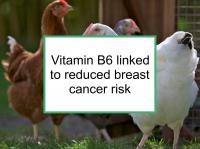The relationship between intake of various B vitamins and breast cancer risk is complex and studies have produced conflicting results. Part of the problem is that, in the U.S., many grain products such as flour, rice, pasta, bread and cereals contain added folic acid (a synthetic form of folate) as a result of mandatory fortification regulations.
Folate, a B vitamin, interacts with other B vitamins in influencing breast cancer risk and prognosis. Also, the rate of supplementation with B vitamins tends to be higher in the U.S. than some other countries such as China in which major studies have taken place. Therefore, studies of the influence of various types of vitamin B on breast cancer risk may not be comparable. However, the picture is becoming somewhat clearer for vitamin B6 (pyridoxine).
Studies that have investigated the link between vitamin B6 intake and risk of breast cancer have for the most part found no association or a negative association (indicating a reduction in risk) for women with relatively high intake. In particular, in Chinese populations whose intake is primarily through diet rather than supplementation, relatively high levels of vitamin B6 are associated with lower risk of breast cancer. On the other hand, one U.S. study that included 38,772 women in the Iowa Women's Health Study reported an absolute 4.1% increase in breast cancer risk for postmenopausal women taking supplements containing vitamin B6. Now a new meta-analysis of previous studies has reported that relatively high levels of circulating vitamin B6 (from both food sources and supplements) are associated with reduced risk of breast cancer in postmenopausal women.
Sources of vitamin B6
Vitamin B6 is used in a wide variety of processes in the body, having a role in over 100 enzyme reactions, for the most part concerned with protein metabolism. Vitamin B6 is found in a variety of foods. The most abundant dietary sources include chickpeas, beef (especially liver and other organ meats), fish such as tuna and salmon, chicken and turkey, fortified cereals, potatoes and other starchy vegetables, and bananas.
Latest research finds link between high vitamin B6 and lower risk
The meta-analysis referenced at the beginning of this news story was designed to investigate the associations between vitamin B6, vitamin B12 and methionine (an essential amino acid) intake and risk of breast cancer. To conduct the study, the authors identified relevant studies by searching PubMed and Web of Knowledge. Women with the highest category of circulating pyridoxal 5΄-phosphate (PLP, an active form of vitamin B6) levels were found to have a 20% lower risk of breast cancer than those with the lowest levels. The risk reduction for dietary methionine intake was 6%. A linear dose-response relationship was observed for both circulating vitamin B6 and dietary methionine.
The reduced breast cancer risk associated with higher circulating vitamin B6 levels and dietary methionine intake were statistically significant only among postmenopausal women (not among premenopausal women). Inverse associations found between breast cancer risk and dietary vitamin B6 intake, circulating vitamin B12 levels and dietary vitamin B12 intake turned out not to be significant.
The authors conclude that serum PLP levels and dietary methionine intake might be inversely associated with risk of breast cancer, especially among postmenopausal women. The findings need to be confirmed.
